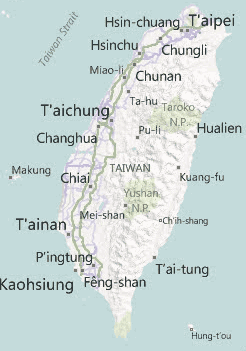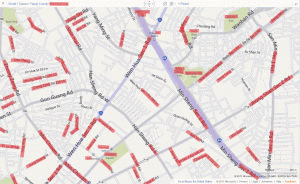The maps of Taiwan put out by GooGle are plagued with errors in their use of Pinyin. But what about that other big company with deep pockets? You know: Microsoft. How good a job does Microsoft’s Bing do with its maps of Taiwan?

I won’t keep y’all waiting: After examining Bing’s maps of Taiwan the two words that came first to mind were incompetent and atrocious.
The country-level map is odd, offering Wade-Giles. And although the use of the hyphen is irregular, I will give Bing points for getting at least Wade-Giles’ apostrophes right. So, although some place names on the map are decades out of date (e.g., Hsin-chuang, Chungli, Chunan, Kuang-fu), at least they’re not horribly misspelled within that system.
It’s at the street level that Bing’s weirdness becomes most apparent. For example, below is part of Bing’s map of Banqiao.
I added the highlighting.
This tiny but representative fragment of the map has not one but four romanization systems:
- MPS2: Gung Guang, Min Chiuan, Shin Fu (Even within MPS2, none of those should have spaces or extra capital letters.)
- Hanyu Pinyin: Banqiao (This is the only properly written place name on this map fragment.)
- Tongyong Pinyin: Jhancian, Sianmin, Sin Jhan
- Gwoyeu Romatzyh(!): Shinjann (This is the same road as the one marked “Sin Jhan”. In Hanyu Pinyin, which is what officially should be used here, this is written “Xinzhan”.)
A few more points about this small fragment of the map:
- Wen Hua could be either MPS2 or Hanyu Pinyin, but not Tongyong Pinyin. And it should be Wenhua.
- Minan is missing an apostrophe. (It should be Min’an.)
- Banchiao is just wrong, regardless of the system. They were probably going for MPS2 but erroneously used an o instead of a u: Banchiau.
- Sec 1 Rd should be Rd Sec. 1.
- Mrt should be MRT.
So that’s four systems, plus additional errors.
There’s much, much more that’s wrong with this than is right. That’s even more evident on a larger map — and that’s without me bothering to mark orthographic problems in the Pinyin (e.g., Wen Hua instead of the correct Wenhua).

Here bastardized Wade-Giles (e.g., “Mrt-Hsinpu” at top, center — and, FWIW, in the wrong location) has been added to the mix, making a total of five different romanization systems, as well as some weird spellings, e.g., U Nung, Win De, Bah De, Ying Sh — and that’s without including my favorite, JRLE, because that one is correct in MPS2 (“Zhile” in Hanyu Pinyin).
The main point is that vast majority of names are spelled wrong. And among the few that are spelled correctly, those that are written with correct orthography can be counted on one hand. So, to the words above (incompetent and atrocious) let me add FUBAR.
The copyright statement lists not only Microsoft but also Navteq. The Taiwan maps on the latter company’s site, however, are different from those on Bing. Navteq’s are generally in Hanyu Pinyin, though almost invariably improperly written (e.g., Tai bei Shi, Ban Qiao Shi). And despite the prevalence of Hanyu Pinyin, they still contain other romanization systems (e.g., Jhong Shan) and outright errors (e.g., Shin Jahn).

So an update from Navteq wouldn’t be nearly enough to fix Bing’s problems, which are fundamental.


I wonder how they collate their information. I suspect programmers write scripts to convert data from various sources into the form needed to apply the labels to the map (text, coordinate…) I doubt anyone sits down and decides what to call each street or place individually. Such automated processes probably apply auto capitalisation, which is why we see “Mrt”, which presumably no human would type. Checking all the maps for the whole world at every zoom level would be a big task, but then Microsoft is a big company so you’d think they might have the resources.
I agree that projects such as this that involve massive amounts of data are likely to be largely automated. But that’s part of what makes this so weird. What sort of automated system would produce a map with five different romanization systems (plus additional errors that aren’t covered by any romanization system) and with some names written solid and other names in Frag Men Ted Syl La Bles? It makes no sense.
Well, you guys should check this out:
http://go.ethantw.net/2uTn
“David Lane”?!
“Taipei City” is in “Taipei County”?!
Sure, it does.
If you use five data sources, some of which use Frag Men Ted Syl La Bles, then you could very well end up with five different romanization systems on the map. The data for arterial streets could come from one source, the data for small lanes could come from another, the data for highways might come from yet a third source.
Navteq data is collected by driving teams. In general, Navteq will go by the street signs, so any errors present will propagate into the data. If there are multiple signs on a road, then it will be the luck of the draw which one gets typed in by the driving team.
Bottom line is: Once Taiwan has standardized its romanization situation, the maps will automatically follow — eventually. Might take a few years for the standardized forms to make their way into the data, however.
David Ln. direct link: http://www.bing.com/maps/?cp=25.030542063025152~121.5659174601279&lvl=17
Disclosure: I work for Microsoft, but in a different area than Bing.
Totally agree with Bing Maps, when it comes to Asia, being not quite perfect (to put it politely). That said, I don’t think pointing at either Bing directly or Navteq as the source for improvement is useful. A huge part of the recent partnership announcement between Microsoft and Nokia was getting the Nokia local information (including maps) shifted over to the Bing platform. Unlike Bing (which has almost no presence outside North America) and Google (limited but larger international footprint), Nokia is a huge presence in Asia. I don’t have a link to compare them, but I do know that navigating using Google maps in TPHCM in Vietnam was poor, Bing Maps were unusable, but every cabbie has a Nokia phone with maps that they use for navigation it seems, so my guess is you’ll see Bing drastically improving sometime in 2012 as the partnership starts getting tools to market.
Interesting. Thanks, Marc.
I just had a look at Nokia’s Ovi Map for the same part of Banqiao. It looks like Nokia and Navteq have the same data source. Both have mainly Hanyu Pinyin as broken syllables but also have Tongyong’s “Jhong Shan” (rather than “Zhongshan”), MPS2’s “Fujung” (rather than “Fuzhong”), and the highly distinctive error of “Shin Jahn” (for Xinzhan).
I looked elsewhere and also spotted another distinctive error: “Zhong Qing” for “Chongqing”. (Google also has this mistake.)
So a switch to Nokia as the data provider is unlikely to improve the situation.
Whoever is supplying this data to Bing, Navteq, and Nokia clearly knows nothing about Hanyu Pinyin or how it’s supposed to work. But I’d be willing to bet they were well paid anyway.
SDI Spotlight:
…through the advent of Google Maps, Google Earth and Bing Maps, the representation of maps has come to be taken for granted. Google Maps for example, is accessed by many people in their daily lives to identify and view properties, to find directions etc without any thought as to how the data has been compiled and, most importantly, how accurate or current is that data…
http://www.facebook.com/xinbeicity/posts/156221031101843
Bing Maps ???
The way Google Maps “translate” place names on the mainland maps (and there, of course, there are no multiple transcriptions problems domestically!) is also interesting, It appears that they start with the original names written in Chinese characters, and then apply an algorithm not too different from what they use in Google Translate, but more geared for working with placenames (so more components get transcribed, and fewer translated into English). This is presumably based on working against some very large bilingual database of examples, and “translating” certain “commonly translatable” terms by analogy, using Hanyu Pinyin transcription for everything that’s not translated.
The results in most cases are reasonable, but there are lots of funny cases too, with a strange mishmash of translated and transcribed morphemes. For example, let’s take a look at this map of a section of Qufu, Shandong:
http://maps.google.com/maps?q=35.597658,116.984046&num=1&sll=35.600439,116.989589&sspn=0.015702,0.042272&ie=UTF8&ll=35.595344,116.981006&spn=0.003926,0.010568&z=17
The Qufu City Islamic Association (?????????, Qufu Shi Yisilanjiao Banhui) became “Qufushi Yisilanjiao Association”, while the nearby Shuanglong (Double Dragon) Shopping Plaza (??????) becomes “Ssongyong Shopping Plaza”. The latter must be due to the same effect I observe occasionally in Google Translate: if a particular Chinese phrase looks the same like a common Korean or Japanese proper name (place name, company name etc) they may translate it by giving that Korean (or, elsewhere, Japanese) name.
(That looks like a rather long link there, Vlad.
I tidy mine by choosing just a few http://mapki.com/wiki/Google_Map_Parameters .)
This doesn’t really surprise me at all. It was only a short time ago that you could drive down a street in Taipei and you would encounter several systems on the street signs. However, even worse than the various spellings is there decision to start using a system of numbered streets, such as 7th Boulevard and 12th Avenue instead of names. Apparently Taipei City created a system once upon a time, but the only place I have ever seen it used is Bing Maps. It would be interesting to get in a cab and ask to go to the corner of 7th Boulevard and 12th Avenue and see where you ended up.